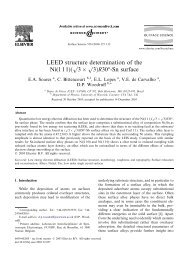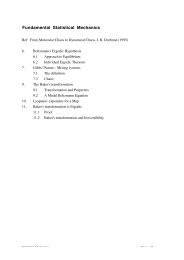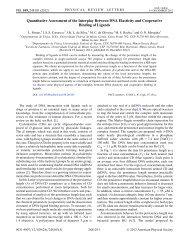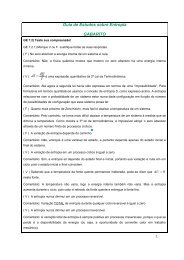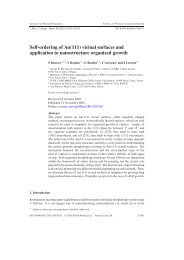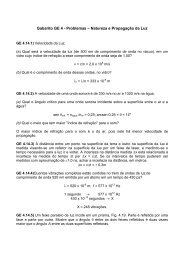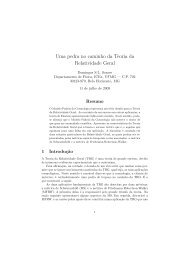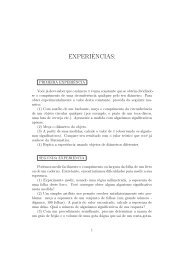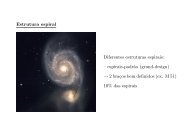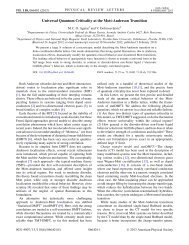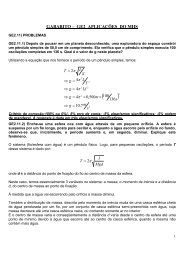Structure of the cobalt-filled missing-row reconstruction of Pt(110)
Structure of the cobalt-filled missing-row reconstruction of Pt(110)
Structure of the cobalt-filled missing-row reconstruction of Pt(110)
Create successful ePaper yourself
Turn your PDF publications into a flip-book with our unique Google optimized e-Paper software.
<strong>Structure</strong> <strong>of</strong> <strong>the</strong> <strong>cobalt</strong>-<strong>filled</strong> <strong>missing</strong>-<strong>row</strong> <strong>reconstruction</strong> <strong>of</strong> <strong>Pt</strong>(<strong>110</strong>)<br />
C. Klein, 1 R. Koller, 1 E. Lundgren, 2 F. Máca, 3,4 J. Redinger, 1,4 M. Schmid, 1, * and P. Varga 1<br />
1 Institut für Allgemeine Physik, Vienna University <strong>of</strong> Technology, Wiedner Hauptstr. 8-10, A-1040 Vienna, Austria<br />
2 Department <strong>of</strong> Synchrotron Radiation Research, Institute <strong>of</strong> Physics, University <strong>of</strong> Lund, Box 118, S-221 00 Lund, Sweden<br />
3 Institute <strong>of</strong> Physics ASCR, Na Slovance 2, CZ-182 21 Praha 8, Czech Republic<br />
4 Center for Computational Materials Science, Getreidemark 9/134, A-1060 Wien, Austria<br />
(Received 17 March 2004; revised manuscript received 28 July 2004; published 18 October 2004)<br />
The atomic structure <strong>of</strong> 0.5 monolayer (ML) Co deposited on <strong>Pt</strong>(<strong>110</strong>) was investigated by quantitative<br />
low-energy electron diffraction and ab initio density functional <strong>the</strong>ory calculations, showing a pronounced<br />
inward relaxation and a filling <strong>of</strong> <strong>the</strong> <strong>missing</strong>-<strong>row</strong> sites <strong>of</strong> <strong>the</strong> <strong>Pt</strong>(<strong>110</strong>) substrate by Co atoms. Up to this Co<br />
coverage no significant intermixing <strong>of</strong> <strong>Pt</strong> atoms with Co atoms was observed by scanning tunneling microscopy,<br />
resulting in an alternating arrangement <strong>of</strong> pure Co and <strong>Pt</strong> <strong>row</strong>s.<br />
DOI: 10.<strong>110</strong>3/PhysRevB.70.153403 PACS number(s): 68.47.De, 61.14.Hg, 68.37.Ef, 68.43.Bc<br />
Due to <strong>the</strong> fact that ultrathin Co/<strong>Pt</strong> multilayers (Co layers<br />
thinner than 10 Å) show perpendicular magnetic anisotropy<br />
and large magneto-optical signals, <strong>the</strong>y are regarded as candidates<br />
for high-density magneto-optical recording media 1<br />
and were consequently thoroughly investigated during <strong>the</strong><br />
last decade. 2 The origin <strong>of</strong> <strong>the</strong> perpendicular anisotropy is<br />
thought to be caused by a combination <strong>of</strong> structural and morphological<br />
effects but still not completely understood. So far<br />
<strong>the</strong> main focus <strong>of</strong> research lay on <strong>the</strong> Co/<strong>Pt</strong>111 interface<br />
which is reported to show <strong>the</strong> largest anisotropy. 3–8 In this<br />
paper, however, we present results on <strong>the</strong> structural details <strong>of</strong><br />
0.5 monolayer [ML; 1 ML equals <strong>the</strong> number <strong>of</strong> <strong>Pt</strong> atoms in<br />
an unreconstructed <strong>Pt</strong>(<strong>110</strong>) plane] <strong>of</strong> <strong>cobalt</strong> deposited on a<br />
<strong>Pt</strong>(<strong>110</strong>) surface. The structural anisotropy inherent to <strong>the</strong><br />
<strong>Pt</strong>(<strong>110</strong>) substrate renders this system particularly suitable for<br />
studying <strong>the</strong> relationship between geometry and magnetism.<br />
Moreover, since <strong>the</strong>re is almost no intermixing <strong>of</strong> Co with <strong>Pt</strong><br />
atoms at this coverage (as shown below), only <strong>missing</strong>-<strong>row</strong><br />
sites are occupied by <strong>cobalt</strong>, resulting in alternating Co-<br />
<strong>Pt</strong>-Co <strong>row</strong>s, which build up a template that could be used for<br />
<strong>the</strong> g<strong>row</strong>th <strong>of</strong> one-dimensional ordered nanostructures. Additionally,<br />
an ordered bimetallic surface like <strong>the</strong> one described<br />
above would be very attractive for studies <strong>of</strong> site-specific<br />
adsorption. Although a filling <strong>of</strong> <strong>the</strong> <strong>missing</strong>-<strong>row</strong> sites by<br />
<strong>cobalt</strong> has been observed in <strong>the</strong> early g<strong>row</strong>th stages before, 9<br />
detailed information on <strong>the</strong> exact atomic structure is still<br />
<strong>missing</strong>.<br />
In this paper we present a quantitative low-energy electron<br />
diffraction (LEED) analysis and ab initio density functional<br />
<strong>the</strong>ory calculations <strong>of</strong> <strong>the</strong> low-coverage p12-<br />
Co/<strong>Pt</strong><strong>110</strong> structure described above, supported by scanning<br />
tunneling microscopy STM, Auger-electron spectroscopy<br />
AES, and ion-scattering spectroscopy ISS results.<br />
The agreement between experimental and<br />
<strong>the</strong>oretical findings is very good indeed, fur<strong>the</strong>r confirming<br />
<strong>the</strong> correctness <strong>of</strong> <strong>the</strong> presented values.<br />
For our experimental study, a <strong>Pt</strong>(<strong>110</strong>) crystal was cleaned<br />
by cycles <strong>of</strong> sputtering with 2-keV Ar + ions, followed by an<br />
annealing step at 850 °C. According to AES measurements<br />
<strong>the</strong> sample was free from disturbing contaminations. The<br />
<strong>cobalt</strong>-<strong>filled</strong> <strong>missing</strong>-<strong>row</strong> structure was prepared by evaporating<br />
0.5 ML <strong>of</strong> Co from a water-cooled electron beam<br />
evaporator, while <strong>the</strong> sample was kept at room temperature.<br />
PHYSICAL REVIEW B 70, 153403 (2004)<br />
The amount <strong>of</strong> deposited Co was determined using a quarz<br />
crystal microbalance and subsequently checked by ISS.<br />
All measurements were done in Vienna in two separate<br />
UHV chambers with base pressures better than 510 −11<br />
mbar. The STM images were taken at room temperature by a<br />
customized Omicron micro-STM with an electrochemically<br />
etched W tip in constant current mode with <strong>the</strong> sample at<br />
negative voltage. Prior to all STM measurements, however,<br />
an additional chamber with a base pressure below<br />
10 −10 mbar was used for sample preparation. The LEED<br />
measurements were performed in <strong>the</strong> o<strong>the</strong>r UHV system at<br />
normal incidence <strong>of</strong> <strong>the</strong> primary electron beam using a twogrid<br />
system and video data acquisition. The LEED patterns<br />
were stored as 8-bit images and subsequently analyzed by an<br />
image processing program which extracted <strong>the</strong> I-V spectra<br />
for each visible beam. In order to improve <strong>the</strong> quality <strong>of</strong> <strong>the</strong><br />
recorded images, an image processing sequence similar to<br />
<strong>the</strong> one used for astronomical charge-coupled device<br />
images 10 was implemented prior to <strong>the</strong> evaluation <strong>of</strong> <strong>the</strong> spot<br />
intensities (see Ref. 11). For <strong>the</strong> LEED calculations <strong>the</strong><br />
TENSERLEED program package 12 was used, where an energy<br />
dependent real part <strong>of</strong> <strong>the</strong> inner potential 13 that accounts for<br />
<strong>the</strong> variation <strong>of</strong> <strong>the</strong> exchange potential with energy was<br />
implemented. This energy dependence <strong>of</strong> <strong>the</strong> inner potential<br />
and <strong>the</strong> phase shifts <strong>of</strong> <strong>the</strong> different atomic sites were calculated<br />
for <strong>the</strong> given structure. To determine <strong>the</strong> agreement<br />
between measured and calculated I-V curves <strong>the</strong> Pendry R<br />
factor 14 was chosen. The error bars given in this paper were<br />
derived from Pendry’s variance, 14 namely by varying a certain<br />
parameter away from <strong>the</strong> best-fit structure until <strong>the</strong> difference<br />
between <strong>the</strong> according R factor got larger than this<br />
variance. To reduce <strong>the</strong> computational effort, all o<strong>the</strong>r parameters<br />
were fixed to <strong>the</strong>ir best-fit value, i.e., no subsequent<br />
reoptimization was performed. This neglect <strong>of</strong> parameter<br />
correlations is a standard procedure in today’s LEED analyses<br />
and can result in a slight underestimation <strong>of</strong> <strong>the</strong> error<br />
limits. 15<br />
First principles density functional <strong>the</strong>ory (DFT) calculations<br />
were performed using both <strong>the</strong> all-electron fullpotential<br />
linearized augmented plane wave 16 code FLAIR<br />
(Ref. 17) and <strong>the</strong> Vienna ab initio simulation package<br />
(VASP). 18,19 The surface was modeled using a nine-layer<br />
single slab with vacuum on both sides for FLAIR and 9- or<br />
1098-0121/2004/70(15)/153403(4)/$22.50 70 153403-1<br />
©2004 The American Physical Society
BRIEF REPORTS PHYSICAL REVIEW B 70, 153403 (2004)<br />
FIG. 1. STM image taken after <strong>the</strong> deposition <strong>of</strong> 0.5 ML Co on<br />
<strong>the</strong> p12-reconstructed <strong>Pt</strong>(<strong>110</strong>) surface (200105 Å 2 , −0.5<br />
mV, 4.24 nA). The image has been contrast enhanced in order to<br />
facilitate <strong>the</strong> distinction between <strong>cobalt</strong> and platinum atoms.<br />
11-layer repeated slabs with 16 Å vacuum in between for<br />
VASP. All slabs were symmetric with respect to <strong>the</strong> middle<br />
layer, allowing us to relax four (five) layers. Two DFT potential<br />
approximations have been used: <strong>the</strong> local density approximation<br />
(LDA) according to Vosko, Wilk, and Nusair 20<br />
and <strong>the</strong> generalized gradient approximation (GGA) according<br />
to Perdew and Wang. 21 Since <strong>the</strong> local density approximation<br />
(LDA) reproduces <strong>the</strong> experimental lattice constant<br />
<strong>of</strong> platinum with very small error [−0.3 to −0.5% (Refs. 22<br />
FIG. 2. Side view <strong>of</strong> <strong>the</strong> structural model considered by LEED<br />
(not to scale).<br />
and 23)] we have used <strong>the</strong> experimental value <strong>of</strong> a=3.92 Å<br />
(Ref. 24) for <strong>the</strong> LDA calculations. For GGA <strong>the</strong> calculated<br />
bulk value <strong>of</strong> 3.984 Å was taken. The spin-polarized calculations<br />
employed a plane-wave cut<strong>of</strong>f energy E cut<br />
=14.44 Ry for FLAIR and 19.7 Ry for VASP. The k mesh<br />
consisted <strong>of</strong> 15 (25, including <strong>the</strong> points at <strong>the</strong> boundaries)<br />
special points in <strong>the</strong> irreducible wedge <strong>of</strong> <strong>the</strong> twodimensional<br />
Brillouin zone for <strong>the</strong> VASP (FLAIR) calculations.<br />
The geometry was optimized until all forces were smaller<br />
than 0.01 eV/Å.<br />
Figure 1 shows an STM image <strong>of</strong> <strong>the</strong> Co-<strong>filled</strong> <strong>Pt</strong>(<strong>110</strong>)<br />
FIG. 3. Comparison between experimental (black) and calculated (gray) LEED I-V spectra <strong>of</strong> <strong>the</strong> best-fit model <strong>of</strong> <strong>the</strong> <strong>cobalt</strong>-<strong>filled</strong><br />
<strong>missing</strong>-<strong>row</strong> structure <strong>of</strong> <strong>Pt</strong>(<strong>110</strong>). The Pendry R factor is 0.24.<br />
153403-2
BRIEF REPORTS PHYSICAL REVIEW B 70, 153403 (2004)<br />
TABLE I. Comparison between LEED and DFT (both LDA and GGA) results for <strong>the</strong> <strong>cobalt</strong>-<strong>filled</strong> <strong>Pt</strong>(<strong>110</strong>)<br />
structure. Here, d ij denotes <strong>the</strong> averaged vertical distance between layer i and layer j and d ij its change with<br />
respect to <strong>the</strong> bulk value. b i and p i represent <strong>the</strong> buckling and lateral displacements (pairing) <strong>of</strong> <strong>the</strong> atoms in<br />
layer i, respectively (buckling is positive for outwards movement <strong>of</strong> <strong>the</strong> Co <strong>row</strong> and atoms below, pairing is<br />
positive for movement towards <strong>the</strong> Co <strong>row</strong>). v Xi stands for <strong>the</strong> vibrational amplitude <strong>of</strong> atom X in layer i.<br />
LDA 9L and GGA 9L denote results for a 9-layer slab obtained with FLAIR and VASP, respectively, LDA 11L<br />
denotes VASP results for a 11-layer slab.<br />
Parameters LEED LDA 9L LDA 11L GGA 9L<br />
v <strong>Pt</strong>1 Å 0.13±0.035 — — —<br />
v Co1 Å 0.17±0.02 — — —<br />
b 1 Å −0.01±0.03 −0.11 −0.08 −0.05<br />
d 12 Å −0.31±0.01 −0.40 −0.40 −0.39<br />
v <strong>Pt</strong>2 Å 0.17±0.04 — — —<br />
p 2 Å 0.09±0.05 0.08 0.09 0.11<br />
d 23 Å 0.14±0.03 0.17 0.17 0.23<br />
v <strong>Pt</strong>3 Å 0.13±0.03 — — —<br />
b 3 Å 0.06±0.04 0.06 0.07 0.06<br />
d 34 Å −0.03±0.025 −0.05 −0.05 −0.01<br />
v <strong>Pt</strong>4 Å 0.11 — — —<br />
p 4 Å 0.04±0.04 0.02 0.02 0.01<br />
d 45 Å 0.00±0.024 0.00 0.00 0.04<br />
b 5 Å 0.03±0.04 — 0.01 —<br />
d bulk 1.386 1.386 1.386 1.409<br />
R Pe 0.24 — — —<br />
<strong>missing</strong>-<strong>row</strong> structure. As in Ref. 25 <strong>the</strong> brighter atomic species<br />
corresponds to <strong>Pt</strong> atoms, whereas Co atoms are depicted<br />
as slightly darker protrusions. A closer inspection <strong>of</strong> Fig. 1<br />
reveils <strong>the</strong> fact that almost all <strong>missing</strong>-<strong>row</strong> sites are occupied<br />
by Co atoms, thus leveling <strong>the</strong> former “open” surface. Moreover,<br />
intermixing between <strong>cobalt</strong> and platinum in <strong>the</strong> first<br />
layer is found to be less than 10%. As a result, one can<br />
indeed identify an almost perfectly ordered structure consisting<br />
<strong>of</strong> alternating <strong>row</strong>s <strong>of</strong> <strong>cobalt</strong> and platinum.<br />
In order to be sure to be able to treat <strong>the</strong> encountered<br />
structure with sufficient accuracy by LEED, <strong>the</strong> clean<br />
12-reconstructed <strong>Pt</strong>(<strong>110</strong>) surface was thoroughly analyzed<br />
at first. The results <strong>of</strong> this analysis (not presented in<br />
this paper) are in excellent agreement with <strong>the</strong> most recent<br />
LEED study. 22<br />
For <strong>the</strong> LEED I-V analysis <strong>of</strong> <strong>the</strong> Co/<strong>Pt</strong><strong>110</strong> structure as<br />
shown in Fig. 1, LEED patterns starting from 30 eV up to<br />
400 eV were recorded, with an energy step width <strong>of</strong> 1 eV.<br />
This enabled <strong>the</strong> extraction <strong>of</strong> 20 symmetry-inequivalent<br />
beam sets (ten integer and ten fractional order beams) and<br />
resulted in a cumulative energy range <strong>of</strong> 4594 eV. The only<br />
structural model considered for <strong>the</strong> LEED calculations was<br />
<strong>the</strong> one evident from <strong>the</strong> STM results, i.e., a regular <strong>Pt</strong>(<strong>110</strong>)<br />
structure, where <strong>the</strong> <strong>missing</strong>-<strong>row</strong> sites are <strong>filled</strong> with <strong>cobalt</strong><br />
atoms. In order to account for a possible intermixing <strong>of</strong> Co<br />
with <strong>Pt</strong> atoms in <strong>the</strong> platinum <strong>row</strong>s and <strong>the</strong> existence <strong>of</strong><br />
vacancies in <strong>the</strong> Co <strong>row</strong>s (as visible in Fig. 1), <strong>the</strong> average<br />
t-matrix approximation 26,27 was used, allowing us to treat <strong>the</strong><br />
average atomic-site occupation and <strong>the</strong> average height <strong>of</strong><br />
each atomic species as free parameters. Thereby, upwards or<br />
downwards movement <strong>of</strong> <strong>the</strong> few Co atoms in <strong>the</strong> top <strong>Pt</strong> <strong>row</strong><br />
is included in <strong>the</strong> calculations. Additionally, <strong>the</strong> first five in-<br />
153403-3<br />
terlayer distances as well as <strong>the</strong> vibrational amplitudes <strong>of</strong> <strong>the</strong><br />
first three layers were varied within <strong>the</strong> LEED framework.<br />
Due to symmetry reasons only buckling <strong>of</strong> <strong>the</strong> first, third,<br />
and fifth layer and pairing <strong>of</strong> <strong>the</strong> second and forth layer occurs<br />
(see Fig. 2). The imaginary part V i <strong>of</strong> <strong>the</strong> inner potential<br />
and <strong>the</strong> vibrational amplitudes <strong>of</strong> <strong>the</strong> bulk v bulk, however,<br />
were optimized full dynamically, resulting in V i=5.5 eV and<br />
v bulk=0.11 Å, respectively.<br />
In <strong>the</strong> final structural search 18 parameters were independently<br />
varied, resulting in a Pendry R factor <strong>of</strong> 0.24 (Fig. 3).<br />
The Co occupation <strong>of</strong> <strong>the</strong> <strong>missing</strong>-<strong>row</strong> sites was determined<br />
as 90% ±15%, leaving 10% <strong>of</strong> <strong>the</strong> atomic sites vacant.<br />
Additionally a slight intermixing between platinum and <strong>cobalt</strong><br />
atoms was observed for <strong>the</strong> o<strong>the</strong>rwise pure <strong>Pt</strong> <strong>row</strong>s,<br />
which resulted in <strong>the</strong> substitution <strong>of</strong> 5% ±20% <strong>of</strong> <strong>the</strong>se <strong>Pt</strong><br />
atoms by Co atoms with <strong>the</strong> average Co location being 0.04<br />
Å below <strong>the</strong> <strong>Pt</strong>. The percentage <strong>of</strong> this substitution is too<br />
small, however, to have a significant impact on <strong>the</strong> first interlayer<br />
distance d 12 or <strong>the</strong> inter<strong>row</strong> buckling b 1. Consequently,<br />
<strong>the</strong> LEED and DFT results are easily comparable.<br />
LEED and LDA show very good agreement <strong>of</strong> <strong>the</strong> atomic<br />
positions (cf. Table I) except for <strong>the</strong> vertical position <strong>of</strong> <strong>the</strong><br />
<strong>cobalt</strong> <strong>row</strong>s, which is <strong>the</strong> main reason for different results for<br />
<strong>the</strong> first interlayer spacing. Never<strong>the</strong>less, both methods show<br />
a pronounced inwards relaxation <strong>of</strong> <strong>the</strong> first atomic layer <strong>of</strong><br />
22%LEED/29%LDA, ra<strong>the</strong>r large lateral displacements<br />
<strong>of</strong> <strong>the</strong> platinum atoms <strong>of</strong> <strong>the</strong> second layer and considerably<br />
strong buckling <strong>of</strong> <strong>the</strong> odd <strong>Pt</strong> layers. Compared to <strong>the</strong><br />
<strong>missing</strong>-<strong>row</strong> <strong>reconstruction</strong> <strong>of</strong> pure <strong>Pt</strong>(<strong>110</strong>), 22 <strong>the</strong> inwards<br />
relaxation <strong>of</strong> <strong>the</strong> top <strong>Pt</strong>(<strong>110</strong>) atoms and <strong>the</strong> pairing amplitude<br />
p 2 are significantly larger. We believe that <strong>the</strong> explanation is<br />
as follows: Without <strong>the</strong> presence <strong>of</strong> <strong>the</strong> Co atoms in <strong>the</strong>
BRIEF REPORTS PHYSICAL REVIEW B 70, 153403 (2004)<br />
troughs, <strong>the</strong> tendency <strong>of</strong> <strong>the</strong> second-layer <strong>Pt</strong> atoms towards<br />
inwards relaxation perpendicular to <strong>the</strong> {111} facets counteracts<br />
<strong>the</strong>ir movement into <strong>the</strong> trough necessary to make space<br />
for <strong>the</strong> first-layer <strong>Pt</strong> atom. With <strong>the</strong> small Co atoms in place,<br />
<strong>the</strong> second-layer <strong>Pt</strong> atoms will move towards <strong>the</strong> Co atoms to<br />
reduce <strong>the</strong> Co-<strong>Pt</strong> bonding distance, <strong>the</strong>reby also enabling <strong>the</strong><br />
first-layer <strong>Pt</strong> atom to sink deeper into <strong>the</strong> surface. LDA force<br />
calculations indeed show that <strong>the</strong> pairing <strong>of</strong> <strong>the</strong> platinum<br />
atoms <strong>of</strong> <strong>the</strong> second and fourth layer is directly related to <strong>the</strong><br />
buckling <strong>of</strong> <strong>the</strong> surface Co-<strong>Pt</strong> layer. Therefore one might also<br />
expect that <strong>the</strong> very small buckling <strong>of</strong> <strong>the</strong> first-layer atoms<br />
observed by LEED (in contrast to <strong>the</strong> LDA calculations) will<br />
be accompanied by a small buckling and pairing in <strong>the</strong> subsurface<br />
layers, but this is not <strong>the</strong> case. We ra<strong>the</strong>r find very<br />
good agreement <strong>of</strong> <strong>the</strong> LDA and LEED structural data in <strong>the</strong><br />
subsurface region. This means that <strong>the</strong> reason for <strong>the</strong> very<br />
small inwards relaxation <strong>of</strong> <strong>the</strong> considerably smaller <strong>cobalt</strong><br />
atoms found by LEED is different. We attribute at least part<br />
<strong>of</strong> <strong>the</strong> problem to <strong>the</strong> overbinding <strong>of</strong> 3d metals inherent to<br />
LDA, causing <strong>the</strong> <strong>cobalt</strong> atoms to move towards <strong>the</strong> second<br />
atomic layer and <strong>the</strong>refore increasing <strong>the</strong> buckling, whereas<br />
LDA is known to be almost perfect for clean platinum. 22,23<br />
Indeed, our GGA calculations reveal a reduced buckling in<br />
<strong>the</strong> first layer but a first-layer relaxation similar to LDA,<br />
which causes a slightly different relaxation pattern in <strong>the</strong><br />
deeper layers, <strong>the</strong>reby worsening <strong>the</strong> agreement <strong>of</strong> d 23 with<br />
LEED. Since <strong>the</strong> system is on <strong>the</strong> verge <strong>of</strong> becoming nonmagnetic<br />
in LDA, we have also performed non-spinpolarized<br />
calculations (not shown in Table I), yielding a<br />
larger first-layer buckling due to <strong>the</strong> smaller size <strong>of</strong> a non-<br />
*Electronic address: schmid@iap.tuwien.ac.at<br />
1P. F. Carcia, A. D. Meinhaldt, and A. Suna, Appl. Phys. Lett. 47,<br />
178 (1985).<br />
2D. Weller, Y. Wu, J. Stöhr, M. G. Samant, B. D. Hermsmeier, and<br />
C. Chappert, Phys. Rev. B 49, 12 888 (1994); Y. Sonobe, D.<br />
Weller, Y. Ikeda, K. Takano, M. E. Schabes, G. Zeltzer, H. Do,<br />
B. K. Yen, and M. E. Best, J. Magn. Magn. Mater. 235, 424<br />
(2001); M. Yu, Y. Liu, A. Moser, D. Weller, and D. J. Sellmyer,<br />
Appl. Phys. Lett. 75, 3992 (1999).<br />
3P. Grütter and U. T. Dürig, Phys. Rev. B 49, 2021 (1994).<br />
4S. Ferrer, J. Alvarez, E. Lundgren, X. Torrelles, P. Fajardo, and F.<br />
Boscherini, Phys. Rev. B 56, 9848 (1997).<br />
5J. S. Tsay and C. S. Shern, Surf. Sci. 396, 313 (1998).<br />
6E. Lundgren, B. Stanka, W. Koprolin, M. Schmid, and P. Varga,<br />
Surf. Sci. 423, 357 (1999).<br />
7E. Lundgren, B. Stanka, M. Schmid, and P. Varga, Phys. Rev. B<br />
62, 2843 (2000).<br />
8M. Schmid, E. Lundgren, G. Leonardelli, A. Hammerschmid, B.<br />
Stanka, and P. Varga, Appl. Phys. A: Mater. Sci. Process. 72,<br />
405 (2001).<br />
9E. Lundgren, J. Alvarez, X. Torrelles, K. F. Peters, H. Isern, and<br />
S. Ferrer, Phys. Rev. B 59, 2431 (1999).<br />
10C. Buil, CCD Astronomy (Willmann Bell, Richmond, VA, 1991).<br />
11R. Koller, W. Bergermayer, G. Kresse, C. Konvicka, M. Schmid,<br />
J. Redinger, R. Podloucky, and P. Varga, Surf. Sci. 512, 16<br />
(2002).<br />
12V. Blum and K. Heinz, Comput. Phys. Commun. 134, 392<br />
153403-4<br />
magnetic Co atom, without improving <strong>the</strong> agreement <strong>of</strong> <strong>the</strong><br />
interlayer distances with LEED. Thus, it seems hard to reconcile<br />
LEED and DFT both in <strong>the</strong> first and in deeper layers<br />
at <strong>the</strong> same level <strong>of</strong> agreement.<br />
Although <strong>the</strong> intermixing in <strong>the</strong> surface <strong>row</strong>s (<strong>Pt</strong>-Co and<br />
Co vacancies) was found to be ra<strong>the</strong>r low, we cannot exclude<br />
that this intermixing, not considered in our DFT calculations,<br />
might be responsible for a small part <strong>of</strong> <strong>the</strong> LEED vs DFT<br />
discrepancies. Occasional presence <strong>of</strong> larger platinum atoms<br />
in <strong>the</strong> <strong>cobalt</strong> <strong>row</strong>s (and vice versa) changes <strong>the</strong> local geometry<br />
<strong>of</strong> <strong>the</strong> topmost layer. In <strong>the</strong> LEED analysis this effect is<br />
treated in an averaging manner, which will also tend to reduce<br />
<strong>the</strong> buckling amplitude found by LEED. Fur<strong>the</strong>rmore,<br />
<strong>the</strong>re might be also some influence <strong>of</strong> <strong>the</strong> high step density<br />
on <strong>the</strong> quantitative LEED result. Never<strong>the</strong>less, we conclude<br />
that <strong>the</strong> overall agreement between both results is ra<strong>the</strong>r<br />
good and <strong>the</strong> R Pe factor <strong>of</strong> 0.24 is satisfactory for a quantitative<br />
LEED analysis <strong>of</strong> a former “open” surface.<br />
This work was sponsored by <strong>the</strong> Austrian Fonds zur<br />
Förderung der wissenschaftlichen Forschung (START program<br />
Y75), by <strong>the</strong> Grant Agency <strong>of</strong> <strong>the</strong> ASCR (Grant No.<br />
A1010214) and by RTN Project No. HPRN-CT-2000-00143<br />
<strong>of</strong> <strong>the</strong> EC. Financial support by <strong>the</strong> Swedish Research Council<br />
is gratefully acknowledged by E.L. Special thanks go to<br />
Andreas Schmid from <strong>the</strong> Lehrstuhl für Festkörperphysik Erlangen,<br />
who has calculated <strong>the</strong> geometry-optimized phase<br />
shifts and energy dependence <strong>of</strong> <strong>the</strong> inner potential used in<br />
<strong>the</strong> presented LEED study.<br />
(2001).<br />
13J. Rundgren, Phys. Rev. B 59, 5106 (1999).<br />
14J. Pendry, J. Phys. C 13, 937 (1980).<br />
15S. Müller, Ph.D. <strong>the</strong>sis, University Erlangen-Nürnberg, 1996.<br />
16E. Wimmer, H. Krakauer, and A. J. Freeman, Adv. Electron.<br />
Electron Phys. 65, 357 (1985).<br />
17URL: http://www.uwm.edu/~weinert/flair.html.<br />
18G. Kresse and J. Furthmüller, Phys. Rev. B 54, 11 169 (1996);<br />
URL:http://cms.mpi.univie.ac.at/vasp/<br />
19G. Kresse and D. Joubert, Phys. Rev. B 59, 1758 (1999).<br />
20S. H. Vosko, L. Wilk, and M. Nusair, Can. J. Phys. 58, 1200<br />
(1980).<br />
21Y. Wang and J. P. Perdew, Phys. Rev. B 44, 13 298 (1991).<br />
22V. Blum, L. Hammer, K. Heinz, C. Franchini, J. Redinger, K.<br />
Swamy, C. Deisl, and E. Bertel, Phys. Rev. B 65, 165408<br />
(2002).<br />
23A. Khein, D. J. Singh, and C. J. Umrigar, Phys. Rev. B 51, 4105<br />
(1995).<br />
24W. B. Pearson, Lattice Spacings and <strong>Structure</strong> <strong>of</strong> Metals and Alloys<br />
(Pergamon, Oxford, 1967).<br />
25F. Máca, W. A. H<strong>of</strong>er, and J. Redinger, Surf. Sci. 482-485, 844<br />
(2001).<br />
26Y. Gauthier, Y. Joly, R. Baudoing, and J. Rundgren, Phys. Rev. B<br />
31, 6216 (1985).<br />
27F. Jona, K. O. Legg, H. D. Shih, D. W. Jepsen, and P. M. Marcus,<br />
Phys. Rev. Lett. 40, 1466 (1978).



